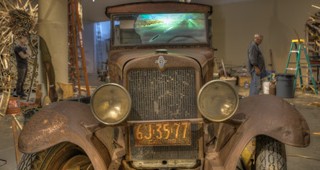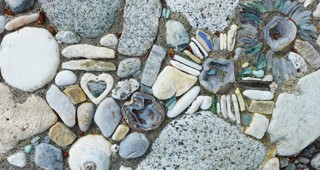How Long To Spend On Getty Center Garden
Seeing by Experiencing: The Central Garden at the Getty Center

Water cascading over, under, and around the chert boulders of the upper stream provide one of the musical moments in the Central Garden. Author's photographs
A sculpture in the form of a garden aspiring to be art . . .
Robert Irwin
In March 2007, I began visiting the Central Garden at the Getty Center in Los Angeles regularly—one morning a week for six months, as it turned out. I wasn't exactly sure why. I later learned precisely why, but in March all I knew was that I would try to leave behind the tools of my trade: notebook, pen, writer's mind, habitual ways of thinking and seeing. I knew if I showed up with a preconceived idea—I will write a story about this garden—my mind would shuffle and organize in a certain predictable way. After four or six visits, and a couple of packed notebooks, I would have said: Enough. I can see the arc of the narrative, the ending. I would be all set—but, with my default setting. How might I rediscover my beginner's mind?
I had first seen the Central Garden in the full glare of the midday sun on a hot day in May, 1998. I was still living and gardening in Western Massachusetts (we moved to Los Angeles in 2005), and, like many gardeners, I walked through the three levels of the garden looking at plants. The color of plants, the shape of plants . . . what are these plants? I like this plant and not that plant. I want these plants . . . can I have those plants? I could return to the East and say I had "seen" the Getty Garden, and that it was quite amazing . . . all those plants.
Nine years later, I would learn to see the Central Garden in all its moods: the play and force of light, temperature, sound, water, texture, density, color, humidity, cloud cover, fragrance, wind, bees, equipment, people, architecture, solitude, moths, noise, waterfowl, hummingbirds, rhythms—all bearing down on my effort to see afresh. That is, trying to see, if only for a moment, without the lapdogs and guard dogs of my likes and dislikes barking away in my ear (to paraphrase Lewis Hyde). "Perception," Robert Irwin, the Central Garden's designer, is fond of saying, "is an activity." What I learned is that perception can be willed, cultivated, invoked, provoked, prayed for, stripped naked for.
In early January, 2002, the painter Nava Grunfeld handed me a documentary film. "You have to see this," she said. It was The Beauty of Questions. Its subject is Robert Irwin.
The film was not the usual here-is-the-art and here-is the artist. Questions were posed: What is it that art does to contribute to our dialogue with the world? One of Irwin's answers: "Art is a continuous effort to catch us up in that moment, when, uncannily, we perceive ourselves perceiving."
Irwin maintains a running commentary through the film on the nature of contemporary art and perception—about the demise of the old idea of art being "encased" in an object. "The subject of art has to do with feelings," he says. "There's a continual confusion between subject and object.
"Art shows you the world in ways you haven't seen it before; it brings you back to look at it again." That's what I was after: looking again and again at the Central Garden, not with pre-cooked ideas about gardens, plants, or art, but with the doors of perception kicked open to the fresh air of experience.
Irwin is not, by any means, the first artist to express this experiential manifesto of contemporary art. But he is passionate and engaging in the film, always asking difficult questions of himself. I began to see the beauty of questions in my own mind. "The questions are always ahead of you," he says, "so you are always flying by the seat of your pants."
When Irwin was asked in the mid-1990s to contribute a design for the Central Garden at the then under- construction Getty Center, he had traveled a road of constant self-transformation as an artist for forty years. (See Lawrence Weschler's 1984 midcareer biography of Irwin, Seeing is Forgetting the Name of the Thing One Sees.)
Irwin didn't see himself designing a "garden" per se; his task was to make a contemporary "sculpture in the form of a garden aspiring to be art," as he repeatedly told the phalanx of engineers, horticulturists, plantsmen, and other consultants brought on board during its construction. Now, eleven years after it opened to the public, the John Paul Getty Museum ranks the Central Garden as one of its most significant pieces of contemporary art; oversight of the garden is in the hands of the associate director for collections.

An array of succulents fills the author's favorite corner at the top of the Central Garden's stream in winter
The First Month
March 20, 2007. None of this was on my mind when I walked with a disposable camera through the Central Garden. It was a misty, coldish day. Umbrellas were blooming. Snap, snap, snap—single shots of plants. Hurried shots of slivers of plants in the Stream Garden—sedums and stachys, echeveria and euphorbia. Those famous London plane trees were bare. I peered down into the Bowl Garden from the garden's plaza; the water-bound azalea maze was, remarkably, in flower. Two photographs taped together show the maze iced with red, pink, and white, perhaps at the peak of bloom. A closer look at the photographs reveals a missing section of the kalanchoe ring above the maze.
March 29, a sunny day. Azaleas are fading on top of the maze. I'm still snapping at random.
April 4, sunny. Still strong color in the azaleas, but today there is a crew of four men in waders inside the pool with hoses and clippers. It is the beginning of my fascination with the groundsmen who tend to the never-ending tasks required of this garden.
April 12, the panoramic shooting begins. A composite photograph on that day of the maze is made up of nine photographs, together about twenty inches wide. A worker is digging up more kalanchoe in the ring above the maze. Hazy sun, the air nippy.
April 18. Everything changes. That is, I change. I run down the stairs from the upper level of the Getty Center to the garden as if to meet a lover. I notice there is a shift in my body, a letting go, the moment I see the "corner" of the garden at the head of the Stream Garden—a perfect tapestry of sedums, euphorbia, stachys, sempervivum, kalanchoe, so much else, bordered by a tiny fence. I will snap that corner from then on. (I still love that corner.) I rush down the Stream Garden when I am stopped in my tracks: no sound of water. I am hit with the metaphorical force of those green chert boulders at the head of the Stream Garden. When the water is turned off, I can sense what is missing: the rich, layered dimension of the sight, sound, and smell of the water. The deep tones at the beginning of the stream . . . the change to treble notes as the boulders give way to smaller rocks. The sound of silence and stillness is deafening. There is no doubt: ordinary seeing or hearing is only half-conscious. Most of us, moment by moment, take the world for granted.
The now-almost-completely green azalea maze sits in a drained pool, but looks as lively as ever. The ring of kalanchoe has been stripped; replanting is underway. At least eight men are at work scrubbing the mosaic bottom of the pool or planting succulents. I never tire of looking at the eight taped-up, four-by-six photographs, and the scope of that sense of emptiness and fullness, side by side.
From that day on, the garden owned me, and I owned the garden; that is, I awakened to the kinesthetic and sensual experience of it. Every week until the beginning of September, the garden continued to unfold, and the richness of the experience continued to build. (And to think of the people of the Getty Center who have looked at the Central Garden almost every workday for years . . .) In August, I really didn't want to take a vacation; I would miss the rhythm of my visits. The family prevailed. I came back. It was all still there.

Springtime fireworks provided by Allium schubertii in the Central Garden
Pieces of a Diary
I did take some notes on these weekly visits after all: sensory details I knew would evaporate.
Undated, a night visit: In the darkness of an early spring evening, under pools of soft light, water music falling over rock— articulated rivulets of silver.
April 12: Wind blowing a gale; 40 mph at least. Everything (tables, chairs, stanchions) locked down. Low 60s, though seems much colder. Looked at primary colors and complements; amazed at how long the alliums have been popping up and maturing, and growing much taller than I expected. London plane trees taking their sweet time to leaf out.
May 3: Clear, gorgeous day, little wind. In love with the garden anew. Sound of the water seems to carry my being with it. Bees diving in and out of Iceland poppies—yellow, orange, coral, peach, white. The geometry of this early light—the composition. Shadow from a lamp, the curve of the circle on teak, the undulation of the rust-toned Cor-Ten steel; how have I not seen it before?
May 8: Arrived late and grumpy, almost 10:00 am. Hot day, 78°, maybe 80° already, light breeze. Visitors twirling umbrellas against the white heat of the sun. Private school children in plaid. Public school children. "Look, look what you're listening to," says the docent. An "educator" with the kids, on the California poppies: "They are as soft as babies' bottoms." Then she says, to a parent, who has a rather mysterious fat belly: "This is a great place for metaphors."
No one, of course, needs the Central Garden in order to see—that is, to awaken the fullness of the senses even for five minutes, or ten. Look out the window. Sit in the back yard. Walk into the desert. Irwin speaks again and again about the "wonder of human beings perceiving the world and being sensitive."
I don't know exactly when it was I saw this "sculpture in the form of a garden" in its fullness. But it was felt at last—not just steel or bronze or flower or stalk or stone or wood, but as pure rhythm. It was standing up, swinging around me, and singing.

Panoramic view of the lower portion of the Central Garden at the Getty Museum
More on the Central Garden
Robert Irwin/Getty Garden by Lawrence Weschler (Getty Publications, 1997) is made up mostly of an extended interview with Irwin about the Central Garden.
Jim Duggan's book, Plants in the Getty's Central Garden (Getty Publications, 2003) is a thoughtful and intimate look at the plants the two men chose for the garden. Duggan continues as a guest curator of the Central Garden now that Irwin has retired from this major project.
How Long To Spend On Getty Center Garden
Source: https://www.pacifichorticulture.org/articles/seeing-by-experiencing-the-central-garden-at-the-getty-center/
Posted by: moodyoursend.blogspot.com



0 Response to "How Long To Spend On Getty Center Garden"
Post a Comment